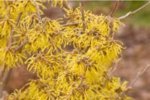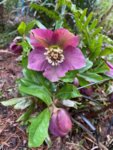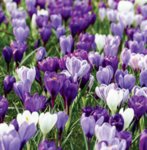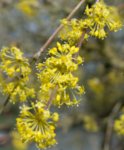



Late winter and early spring can be a lovely time in Clark County gardens and landscapes. There are so many blooming plants that thrive in our climate and are undemanding of busy homeowners.
Who needs to grouse about our gray skies when we have so many options for flowers at this time of year? Here are some favorite trees, shrubs, perennials, vines and bulbs that we recommend to give you a welcome burst of blossoms in late winter.
Trees
• Witch hazel (Hamamelis) is a small vase shaped tree that comes in many colors. It blossoms on bare wood in January through March, depending on the variety. You can find yellow, orange, red, and many shades in between. The flowers are fragrant, smelling something like vanilla.
• Camellia hybrids (Camellia) are technically shrubs but they will grow to about 15 feet, so some think of Camellias as small trees. Many varieties of these evergreen beauties will bloom in late winter. Watching their swelling buds finally burst into bloom is pretty exciting.
• Cornelian cherry (Cornus mas), another choice for a small tree, will brighten a gloomy day with clusters of bright yellow flowers.
Shrubs
• The Lily of the Valley shrub or Andromeda (Pieris japonica) has fountains of bells that hang from the branches in white, pink or hot pink. The bees love them and they have a light sweet scent. Some plants are variegated, but many have dark, glossy evergreen leaves. These are reliably hardy and low maintenance.
• Forsythia is a mounding shrub that is loaded with bright yellow blossoms on arching stems in March. The shrub can grow very large and is common in the area. For smaller spaces, a number of new dwarf varieties are now available as well.
• Winter Daphne (Daphne odora “Aureomarginata”) is an evergreen shrub that is wonderfully fragrant, with its sweetness carrying on the air in March and April. It’s also a very pretty shrub, with long, narrow leaves edged in creamy gold. Its flowers are small and waxy-looking. They emerge from attractive purple buds. Site it near the door or a path and you will adore its heady scent.
• Winter blooming heath (Erica carnea) are small shrubs that produce massive color in winter. Find varieties that flower in white, and shades of pink and magenta. This small shrub is low growing and evergreen.
• Paperbush (Edgeworthia crysantha) provides superb winter interest and a gardenia-like fragrance. It begins to bloom in December on a silhouette of branches with papery bark and continues through the winter. The individual florets are tiny, but a few dozen make up a 1½ to 2-inch cluster of beautiful yellow flowers.
• Buttercup Winterhazel (Corylopsis pauciflora) is a pure delight in late winter. Toward the end of February, half inch-long clusters of pastel yellow flowers shaped like little lanterns dangle on bare branches. Because of its compact habit and slow growth, it is the ideal choice for a small garden.
• Pink Dawn Viburnum (Viburnum × bodnantense “Dawn”) has pink buds that open to pale pink, highly fragrant flowers as early as December. It often still will be blooming when the new leaves emerge in spring. Plant it in mixed borders or informal screen plantings as it can get fairly large.
Perennials
• Lenten rose (Helleborus) is an early bloomer in shades of purple, yellow, apricot, pink and white. There are also double forms and picotees. Large evergreen leaves make it a favorite in Northwest gardens. Be sure to shop when these hellebores are in flower so that you can choose the ones that you like the best.
• Lungwort (Pulmonaria longifolia) has long narrow silver mottled leaves that brighten shady areas. Nectar-rich, clear blue flowers appear in late winter and will continue blooming until late spring. Old mildew-prone varieties have been replaced by those with superior disease resistance so ask for them at your local nurseries.
Vines
• Evergreen Clematis (Clematis armandii) is covered in late winter with small white star-shaped flowers that shine against the bold, leathery, dark green foliage. In full bloom, a heady fragrance fills the air heralding the coming of spring.
Bulbs
• Snow drops (Galanthus nivalis) are a favorite prolific and reliable early spring bulb for the Northwest garden. Their delicate flowers appear in mid to late February. Pure white outer petals partly cover the inner petals, which are tipped with a characteristic green V-shaped mark. They are tiny treasures for the late winter garden.
• Winter aconite (Eranthus hyemalis) is a little showoff in the late winter. Bright yellow cup shaped flowers sit on top of a fringe of green leaves. Plant in large groupings for a dazzling display.
• Crocus flowers give beds and borders and pop of color in February to March. They naturalize beautifully in grassy areas, woodlands, slopes or under trees. Some people plant them in a lawn for a spring meadow effect. They come in yellow, purple, white and shades in between.
We hope that you’re amazed by the variety of plants that bloom in late winter and that you’ll find a spot for one or more of them in your garden.